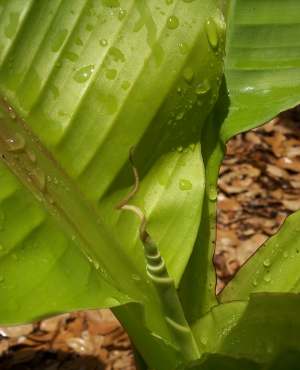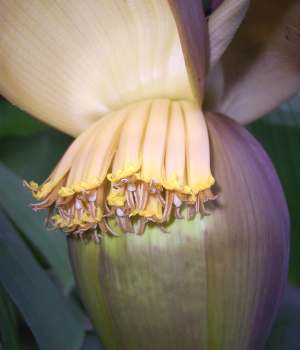|
|
Musaceae
Banana Family
Banana nomenclature is not
perfect. As a result, to be precise, I have had to use the species
name followed by the authority (botanist who published the name), where
it was published and the year it was published. For example, in one
case, I am specifying Musa rubra Wallich ex Kurz, J. Agric. Soc.
India 14: 301. 1867., not Musa rubra Firminger ex Baker, Annals
of Botany. Oxford 7(26): 213. 1893.
While the banana species
on this page are root-hardy perennials in south-central Texas, none will
flower and produce fruit if allowed to freeze. If you want flowers,
the stalks must be dug out in mid- to late-October (or just before a hard
freeze is expected) and have the expanded leaf blades removed, There
is no need to pot them; lay them on the garage floor and forget about them
until late-March. Replant in soil enriched with well-composted manure
and secure with a stake until they re-root. All the Ensete species
require this treatment.
| Musa
'Gran Nain Cross' - Also known as Musa 'X Cross' - A hybrid
of:
Musa acuminata subsp. zebrina 'Sumatrana' and Musa X
'Gran Nain' - Perennial
Many root-hardy bananas thrive
in our area and it is hard to pick a favorite. This hybrid, however, would
be on anyone's top 10 list. It is a cross of a 'Rojo' type with maroon
variegated leaves and one of the outstanding commercial varieties of the
tropics, 'Gran Nain'. The plant photographed here, with a stem about 3
feet tall, is showing the transition from leaves with a green top to the
mature form with maroon blotching. But all leaves, even the lowest ones,
have a maroon underside. It stays under 10' (typically 6' to 8') and bears
small, seedless berries. Grows in full sun to half-day sun. Looks
best if given a deep watering every week during a dry summer. |
|
Ensete glaucum (Roxburgh)
Cheesman, Kew Bull. 2: 101. 1947 (1948). - Also know as: Musa glauca
Roxburgh, Pl. Coromandel 3: 96. 1820. - Snow Banana - Tender Perennial
- Pseudostem to 14' high with a swollen base and marked with black-purple
spots in old plants. Flowering stalk huge, to 8'. Green bracts are many
and give stalk a "reptilian" effect. Fruits dark-purple with a waxy sheen.
Like most Century Plants, these die after flowering, but produce seeds
for the next generation. Even though I know their fate, I can't wait for
mine to flower!
Ensete ventricosum (Welw.)
Cheesman, Kew Bull. 2: 101 1947 (1948). - Abyssinian Banana - Tender
Perennial - A popular ornamental sold by most nurseries.
Ensete ventricosum 'Maurelii'
- Abyssinian Banana - Tender Perennial - A popular ornamental sold by most
nurseries.
Ensete wilsonii (Tutcher)
Cheesman, Kew Bull. 2: 103. 1947 (1948). - Also known as: Musa wilsonii
Tutcher, Gard. Chron., ser. 3, 32: 450. 1902. - Wilson's Snow Banana -
Tender Perennial - Pseudostem massive, to 7' high and 18" in diameter at
base. Flowering stalk to 3'. Bracts green and blooms white. The fruits
are golden yellow. The cold-hardiest forms are from over 8800 feet above
sea level in Yunnan.
Musa acuminata Colla, Mem.
Gen. Musa, 66. 1820. - Banana, Plantain - Perennial - Pseudostems with
black blotches, up to 16' high. Flowering stalk somewhat bent. Bracts
blood-red to purple, tips rarely yellow. Flowers white to pale-yellow.
Wild plants produce seedy fruits. Cultivated forms are seedless and include
varieties like: Musa acuminata 'Dwarf Cavendish'.
Musa acuminata subsp. zebrina
- Sold under the following names: 'Rojo', 'Rubra', 'Sumatrana' or 'Zebrina'
- Perennial - A popular ornamental sold by most nurseries.
Musa balbisiana Colla, Mem.
Gen. Musa, 56. 1820. - Seedy Banana - Perennial - Stalks tall, often bearing
large, black blotches. Inner face of bract purple-red, outer face dull
purple to yellow-green. Blooms light purple with yellow to orange tips.
Pendant flowering stalk, usually with numerous, small fruits.
| Musa basjoo Siebold &
Zuccarini, Verh. Batav. Genootsch. Kunsten 12: 18. 1831. - Basjoo Banana
- Perennial
The most northerly of all
species of banana in nature, from the Ryukyu Islands, off Japan.
Thus, possibly the world's cold hardiest banana. Has long, slender leaves.
Its flowering spike is very attractive, bearing barely edible fruit (small
and seedy) at maturity. The 16' to 20' stalks form large clumps eventually.
Grows in full sun to half-day sun. Looks best if given a deep watering
every week during a dry summer. |

|
|
 |
|
Musa coccinea Andrews, Bot.
Repos. 1: t. 47. 1799. - Also known as: Musa uranoscopos Loureiro,
Flora Cochinchinensis 645. 1790. - Scarlet Banana - Perennial - Pseudostems
4' to 6' high. Upright flowering stalk. Bracts beautiful, pink and blood-red,
crinkled and wavy. Flowers yellow and seedy fruits dirty-white.
Musa formosana (Warburg ex
Schumann) Hayata, Icon. Pl. Formos. 6(Suppl): 83. 1917. - Also known as
Musa paradisiaca L. var. formosana Warburg ex Schumann in
Engler, Pflanzenr. 1(IV. 45): 21. 1900. - Formosan Banana - Perennial -
Pseudostems to 16', in clusters. Flowering stalk downward hanging. Bracts
yellow, ovate, flowers pale yellow. Fruits golden-bronze. Most cold-hardy
forms derived from collections above 3000 foot elevation in Taiwan.
Musa itinerans Cheesman,
Kew Bull. 4: 23. 1949. - Forest Banana - Perennial - Stalks purple in age,
12' to 16' high. Flowering spike recurved, velvety. Inner face of bracts
yellow, outer face dark red-purple, often striped and edged with yellow
bands. Flowers unremarkable. Fruits to 3" long, velvety white, and very
seedy.
Musa ornata Roxburgh, Flora
Indica; or descriptions ... 2: 488-489. 1824. - Thought by some to be of
hybrid origin: Musa flaviflora X Musa velutina - Ornamental
Banana - Perennial - A native of India, now found throught the tropics
and sub-tropics worldwide. It, or its hybrids, is the most common of the
ornamental bananas.
Musa paradisiaca L., Sp.
Pl. 2: 1043. 1753. (Thought to be a hybrid, M. acuminata X M.
balbisiana.) - Also known as: Musa paradisiaca subsp. sapientum
(L.) Kuntze; Musa sapientum L. - Edible Banana - Perennial - The
common edible banana. Many varieties are available.
Musa X Rajapuri - Rajapuri
Banana - Perennial - One of the hardiest and toughest of all the edible
banana cultivars. Generallly stays under 10 feet, is cold hardy and
wind-resistant. The heads of fruit are of moderate size with very sweet,
medium-sized fruit. It is a favorite banana of India. Can be afected by
Root Knot Nematodes and Burrowing Nematodes.
Musa rubra Wallich ex Kurz,
J. Agric. Soc. India 14: 301. 1867. - Not Musa rubra Firminger ex
Baker, Annals of Botany. Oxford 7(26): 213. 1893, which is an invalid name
for Musa sapientum var. rubra. - Red Banana - Perennial - Pseudostems
dark purple, 6' to 10' high. Leaf base spectacular, purple to reddish-purple.
Leaf dark green above and yellow-green below. Flowering stalk upright,
velvety brown with pink bracts. Flowers 5 or 6 per bract, golden yellow.
Fruits red and very seedy.
Musa sanguinea J. D. Hooker,
Bot. Mag. 98: t. 5975. 1872.- Blood Banana - Perennial - Pseudostems 6'
to 8' high with erect flower stalk which ultimately bends downward.
The flowering stalk is velvety brown, the bracts reddish. Flowers 3 per
bract, yellow. Fruits seedy with red markings, 2" to 3" long.
Musa "sikkimensis" - Also
known as: Musa hookeri - Himalayan Banana - Perennial - An attractive,
cold-tolerant banana from the foothills of the Himalaya. The best forms
have the red markings of Musa acuminata subsp. zebrina 'Rojo'.
Musa velutina H. Wendl. &
Drude, Gartenflora 24: 65-67. 1875. - Velvet Banana - Perennial - Forms
a cluster of pseudostems 4' to 9' high. The leaf undersides have a faint
red blush. Flower stalk is erect, with dark pink bracts and pale
yellow blooms. Fruits usually red-purple, with a velvety exterior.
Musa "yunnanensis" - Yunnan
Mountain Banana - Perennial - Plants propagated from high elevation sites
do best in our area.
Musella lasiocarpa (Franchet)
C. Y. Wu ex Li Hsi-wen, Acta Phytotaxonomica Sinica 16(3): 56. 1978. -
Golden Mountain Banana - Perennial - A rare banana relative from 1500 to
2500 m. in southern Guizhou and central to western Yunnan provinces in
China. It is very cold-hardy since it occurs at elevations up to 2800 meters
above sea level, near the Tibetan border. We introduced this exceedingly
rare plant locally in 1999. The plant is spectacular, with succulent, golden
bracts on an upright inflorescence which can exceed six-inches in diameter
and last for months! Golden Mountain Banana grows to approximately 2-meters-high
and does best with shade after 1:00 PM in central Texas. With sufficient
fertilization, plants will form numerous stems in tight clumps, just like
a Canna. Unlike true bananas, wind-damage is not usually a problem with
Musella.
Musella splendida R. V. Valmayor
& L. D. Danh, The Philippine Agricultural Scientist 85 (2): 204 - 209
(2002). - Vietnamese Golden Mountain Banana - Perennial - This newly-described
species is reported to be larger than M. lasiocarpa.
.
|

